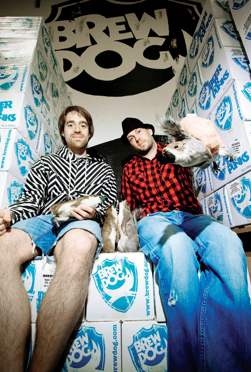
The Brewers Association recently reported dollar sales for America’s small and independent brewers were up another 15 percent over the first half of 2011. The U.S. now boasts 1,790 breweries with another 725 in planning.
But domestic makers aren’t the only ones trying to cash in: crafty beer producers from aboard like Mikkeller and Brew Dog have recognized the demand for full flavored beers in America.
Mikkel Borg Bjergs├©, for which the popular import Mikkeller is named, said he ships almost 50 percent of his product to the U.S. — a staggering amount for a company that made just 4,000 barrels (just north of 1.3 million 12 oz. beers) in 2010.
“We can’t keep up with the demand anywhere at the moment,” said Bjergs├©. “I like to supply my U.S. importer the best I can.”
And that’s a good thing, because with so much growth in the category, at times, U.S. craft brewers are having trouble keeping up with domestic demand. And that means that when distributors and retailers add exciting new foreign varieties, it can help keep consumers happy.
It has also helped the import market overall, as it recovered from a 10 percent decline in 2009 to increase by 5 percent last year, according to the Brewers’ Association, an organization representing craft brewers.
Like many other exporters, Bjergs├© is focusing more closely on the U.S. market than his own backyard, in an attempt to capitalize on the tremendous growth in the craft category over the last two years.
“Denmark is very small and not a lot of people are into craft beer,” he said. “The market is next to nothing and there is very little business opportunity here.”
Bjergs├© added that he plans to up production to nearly 7,000 barrels of beer this year, most of which will be made in styles that many Americans can already find at their local brewery.
“He has really only become this rock star of a brewer by virtue of his sales in the U.S.,” said Will Shelton, one of the founders of Shelton Brothers, a leading beer importer.
Shelton added that nobody could have predicted the success Mikkeller has seen.
“We didn’t have any idea this was going to happen, we just liked his beer,” he said, but he thinks that because it’s from overseas it gives it extra cache, if not a qualitative advantage.
“Let’s face it,” Shelton said.”You can buy a six pack of something similar, made in the U.S. for the same price as a 16 oz. bottle from abroad that sells for $8.”
Knowing that, why are so many American consumers giddy for a beer that mimics what hundreds of brewers are already doing in the U.S.?
Max Toste, owner of Deep Ellum, a craft beer bar in Boston, Mass. that prides itself on serving beer imported from around the world, believes it’s the unusual spin on familiar styles that appeals to the craft community.
“These brewers are totally inspired by the American craft beer scene,” he said. “Mikkel has access to different things in Europe that many American Brewers do not. He has different malts, yeast and equipment that he can utilize to make an American IPA with American hops, and it tastes very foreign.”
And if foreign is what American consumers are clamoring for, look no further than Brew Dog, a brand widely regarded for pushing the boundaries of what’s acceptable — even if that means serving a 55 percent ABV beer in the carcass of a dead squirrel, as it famously did last year with its End of History limited release.
“Our mission has always been to make other people as passionate about great craft beer as we are,” said Co-Founder James Watt. “This is much easier to do in the U.S. than the UK.”
Brew Dog exports 55 percent of its beer, 15 percent of which makes it to the U.S.
“In America, uninhibited, challenging and progressive craft beers are flourishing,” said Watt. “The U.K. is a desert for progressive craft beer.”
So knowing that, are beer enthusiasts “across the pond” demanding American craft beer? If they are, there’s only a small trickle available, again because of the high domestic demand they’re competing against.
The Bruery, from Placentia, Calif., for example, sold just over 3,000 barrels in 2010, but exported less than five percent of that total, according to Manager of Sales and Marketing Benjamin Weiss
“We are not reaching out for international distribution because there is plenty of growth here in the US,” he said. “We only sent some abroad because we were approached by an importer who wanted our beer.”
Editor’s Note: This article will appear in the August issue of Beverage Spectrum Magazine
